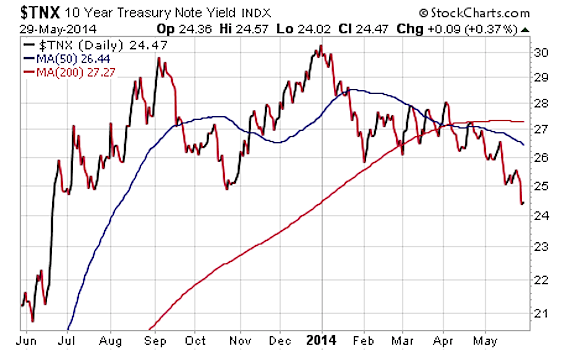 The technical picture for interest rates has continued to resolve lower this year despite the best guesses of leading economists. The CBOE 10 Year Treasury Note Yield (TNX) has descended to an intra-day low of 2.45% this week after coming into the year at a high of 3.00%. This 20% decline has run contrarian to new highs in the SPDR S&P 500 ETF (SPY) and continued reduction in monthly quantitative easing measures by the Federal Reserve.
The technical picture for interest rates has continued to resolve lower this year despite the best guesses of leading economists. The CBOE 10 Year Treasury Note Yield (TNX) has descended to an intra-day low of 2.45% this week after coming into the year at a high of 3.00%. This 20% decline has run contrarian to new highs in the SPDR S&P 500 ETF (SPY) and continued reduction in monthly quantitative easing measures by the Federal Reserve.
Not only has this drop in yields been positive for traditional bond funds such as the iShares 7-10 Year Treasury ETF (IEF), but preferred stocks, REITs, and even utilities have benefited as well. Each of these asset classes has handily beaten the major domestic stock indices in 2014 as portfolio managers reposition their holdings for defense or enhance their income streams.
These depressed yields have many investors wondering which market is going to break first. Will interest rates begin to creep higher along with stocks or is this setting the stage for a deflationary wave that will lead to an overdue correction in equities?
On a short-term time frame, I expect that we will see some backing and filling in interest rates as a function of technical price exhaustion. Most moves in interest rates are stair steps, with gaps down that retrace a portion of the prior move. This is particularly true if equities remain bullish and continue to run higher.
On the flip side, if we do see another wave lower in bond yields, the next area of support on the chart is right around 2.20%. There would likely be a point of consolidation at that level to digest the price action and look for additional opportunities. Keep in mind, the 2013 low was 1.60% on the 10-Year Treasury Yield, and thus there is plenty of room on the downside as well.
At the moment, I am continuing to hold core fixed-income positions that I have owned for quite a while with the expectation that adjustments will be needed to lighten up on credit or duration in the future. Like many investors, I tend to use bonds in my clients portfolios as a method of reducing volatility, balancing equity exposure, and generating income.
Because of the recent extension, I would be cautious about initiating new bond positions at these levels as well. Incrementally adding to new holdings by taking advantage of any pullbacks may be the best opportunity to increase your exposure in the event you are underinvested.
Patience and discipline will serve you well as we navigate these interesting times. Thanks for reading.
Twitter: @fabiancapital
No position in any of the mentioned securities at the time of publication. Any opinions expressed herein are solely those of the author, and do not in any way represent the views or opinions of any other person or entity.









